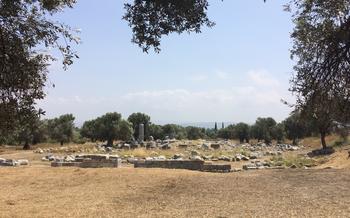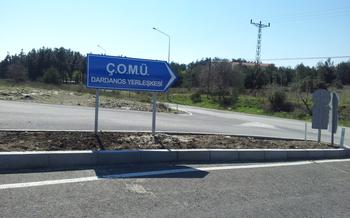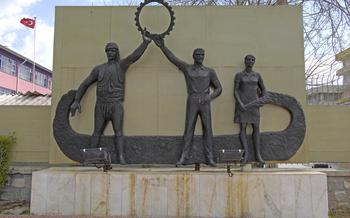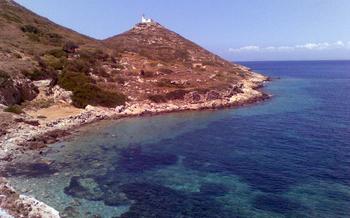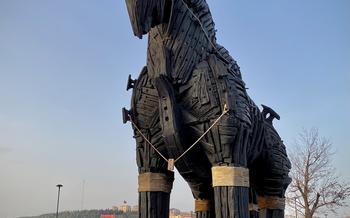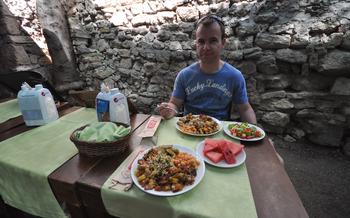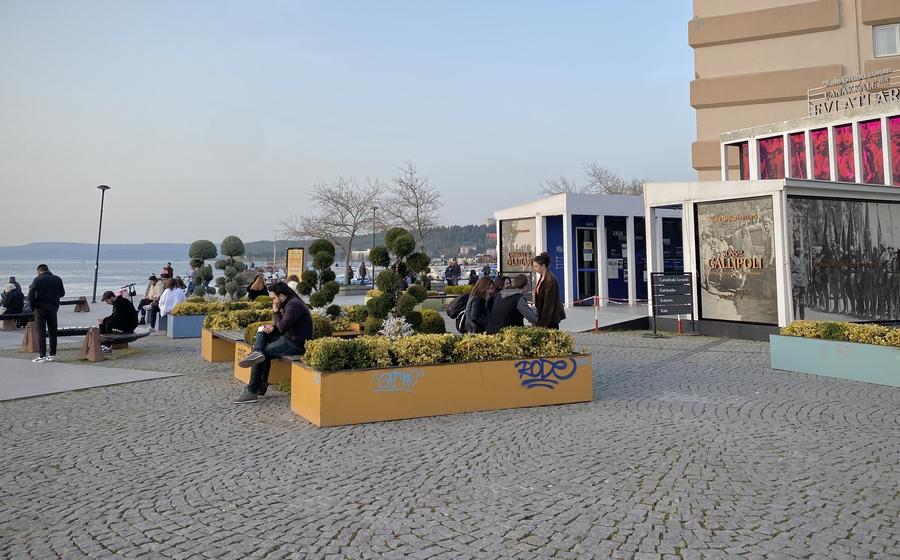
Ancient City of Neandria
- The Antiquity of Neandria:
- Location and Accessibility
- Exploring the Ruins
- Neandria's Fortified Walls: A Testament to Resilience
- The Agora (Marketplace)
- The Odeon (Theatre)
- The Temple of Apollo
- The Necropolis
- Neandria's Coinage: A Window into Economic and Cultural Life
- The Olive Press: A Testament to Ancient Ingenuity
- The Roman Influence
- Byzantine and Ottoman Periods
- Insider Tip: Archaeological Tours
The Antiquity of Neandria:
Neandria, an ancient Greek city located in the northwestern region of Turkey, holds significant historical importance. Founded in the 7th century BC by Ionian settlers from Miletus, Neandria flourished as a vibrant city-state with a rich cultural heritage. Archaeological excavations have uncovered impressive remains of its ancient structures, including fortified walls, a marketplace, a theatre, a gymnasium, a temple dedicated to Apollo, and an extensive necropolis. These discoveries offer a glimpse into the city's past, showcasing its role as a center of ancient Greek culture and its interactions with other civilizations throughout history. Ongoing excavations continue to shed light on the daily lives, religious practices, and economic activities of the Nea ndrians, providing valuable insights into the development of Greek civilization in this region.
Location and Accessibility
Neandria's strategic position on the coast made it a significant port city in ancient times. Today, the ruins are situated approximately 12 kilometers southwest of Çanakkale, offering easy access for visitors. The site can be reached via a scenic drive along the coastal road, providing breathtaking views of the Dardanelles Strait. Alternatively, visitors can opt for a leisurely ferry trip from Çanakkale, enjoying the tranquil waters and coastal vistas during the journey.
Once you arrive at the site, you'll find that Neandria is in close proximity to other notable attractions in Çanakkale. Just a short drive away, you can explore the ancient city of Troy, immortalized in Homer's epic poems. Additionally, the Gallipoli Peninsula, renowned for its historical significance during World War I, is within easy reach, making it possible to combine visits to these sites for a comprehensive historical and cultural experience.
Exploring the Ruins
The ancient city of Neandria, nestled on the picturesque slopes, invites visitors to embark on a journey through time. As you wander through the ruins, you will discover a remarkable layout that reflects the city's meticulous planning. The streets, lined with remnants of ancient structures, lead you to notable landmarks that speak volumes about Neandria's architectural prowess.
The Agora (Marketplace), the bustling heart of the city, stands as a testament to the vibrant commercial activities that once took place here. Surrounding the agora are the ruins of shops, workshops, and public buildings, each contributing to the vibrant tapestry of the city's economic and social life.
The Odeon (Theatre), a smaller version of the renowned amphitheaters, echoes with the voices of performers and the laughter of audiences from centuries past. Its well-preserved seating arrangements and impressive acoustic features offer a glimpse into the world of entertainment and cultural expression in ancient Neandria.
The Temple of Apollo, a sanctuary dedicated to the revered Greek deity, exudes an aura of sacredness. Its grand architecture, adorned with intricate carvings and sculptures, showcases the artistic and religious fervor of the city's inhabitants.
As you continue your exploration, you will encounter the Gymnasium and Baths, which played a significant role in ancient Greek culture. The gymnasium, with its open spaces and training facilities, provided a venue for physical exercise and the pursuit of athletic ideals. The elaborate bath complexes, with their hot and cold pools, offered a sanctuary for relaxation and social interaction.
The Necropolis, the city of the dead, offers a glimpse into the funerary practices and customs of ancient Neandria. Various types of tombs, from simple graves to elaborate mausoleums, reveal the diverse social and economic status of the city's inhabitants.
Throughout the ruins, you will find preserved artifacts and inscriptions that provide valuable insights into the daily lives, beliefs, and cultural practices of the ancient Nea ndrians. These relics, displayed in the Archaeological Museum of Çanakkale, further enrich our understanding of this remarkable city's history and legacy.
Neandria's Fortified Walls: A Testament to Resilience
The fortified walls of Neandria stand as testaments to the city's resilience and strategic importance. Constructed during the 4th century BC, these walls served as a formidable defense against potential invaders. Built using massive stone blocks, the walls stretched for several kilometers, encircling the entire city and providing protection from all sides.
The walls were meticulously designed to maximize their defensive capabilities. They featured a series of towers and bastions, providing vantage points for archers and guards to keep watch over the surrounding area. The gateways were strategically positioned, allowing controlled access to the city while maintaining security.
The construction of the walls involved intricate techniques and a high level of craftsmanship. The massive stone blocks were carefully quarried, shaped, and fitted together without the use of mortar. This impressive feat of engineering ensured the walls' longevity and stability, allowing them to withstand the test of time.
The fortified walls not only served a defensive purpose but also played a crucial role in the city's daily life. They provided a sense of security and protection to the inhabitants, allowing them to thrive and prosper within the city's confines. The walls also functioned as a symbol of Neandria's strength and independence, deterring potential aggressors and safeguarding the city's autonomy.
The Agora (Marketplace)
The agora, or marketplace, was a vital hub of activity in ancient Neandria. It served as a central gathering place for trade, commerce, and social interaction. The agora's layout was typically rectangular, with colonnaded porticoes lining its perimeter. Within these colonnades, merchants set up their stalls, displaying their wares for sale. The agora was not merely a place for buying and selling goods; it also functioned as a venue for public assemblies, political debates, and religious ceremonies.
The agora of Neandria has been extensively excavated, revealing a wealth of artifacts that shed light on the city's vibrant commercial and social life. Among the most notable finds are a collection of stone weights and measures, used for ensuring fair trade, as well as a variety of coins, indicating the use of currency in transactions. The presence of imported goods, such as pottery from Athens and glass vessels from the eastern Mediterranean, attests to Neandria's far-reaching trade connections.
The agora's architectural design reflects its multifunctional nature. The colonnades provided shade and shelter from the elements, while also creating a visually appealing and orderly space. The agora was also adorned with statues of gods and heroes, which served both a religious and decorative purpose. These statues not only paid homage to the city's patron deities but also contributed to the overall aesthetic of the public space.
The Odeon (Theatre)
The odeon, or theatre, of Neandria was a significant cultural and entertainment center in the ancient city. Constructed during the Hellenistic period, it served as a venue for theatrical performances, musical concerts, and other events that brought the community together. The odeon's seating arrangements were designed to provide optimal acoustics, allowing the actors' voices to carry throughout the auditorium. The theatre's strategic positioning within the city ensured easy access for residents and visitors alike.
The odeon's well-preserved remains reveal intricate architectural details and decorative elements. The stage area, where actors performed, is still visible, along with the seating tiers that once accommodated spectators. Inscriptions and carvings adorn the theatre's facade, providing glimpses into the cultural and artistic expressions of Neandria's inhabitants.
The odeon played a crucial role in promoting the arts and fostering a sense of community among the ancient Nea ndrians. Its legacy continues to inspire modern-day visitors, who can imagine the vibrant atmosphere and lively performances that once filled this historic venue.
The Temple of Apollo
Among the sacred edifices of Neandria, the Temple of Apollo stands as a testament to the city's deep reverence for the Olympian deity. Apollo, the radiant god of light, music, and prophecy, held a prominent place in Greek mythology and religion. The temple, dedicated to his worship, served as a focal point for religious rituals and ceremonies.
The architectural grandeur of the Temple of Apollo reflects the significance accorded to this divine figure. Constructed in the classical Greek style, the temple showcased elegant Doric columns that framed its imposing façade. Its interior, adorned with intricate carvings and sculptures, exuded an atmosphere of awe and devotion.
Within the temple's sacred precincts, priests performed elaborate rituals to honor Apollo and seek his guidance. Devotees flocked to the temple to offer prayers, make offerings, and seek oracles from the god's revered priests. The temple also hosted grand festivals and celebrations in Apollo's name, drawing participants from far and wide.
For the people of Neandria, the Temple of Apollo represented a tangible connection to the divine realm. It was a place where they could commune with the gods, seek blessings, and find solace in times of adversity. The temple's enduring legacy serves as a reminder of the deep spiritual beliefs and practices that shaped the lives of Neandria's ancient inhabitants.
The Necropolis
The necropolis, or cemetery, of ancient Neandria is a poignant reminder of the city's rich past and the enduring rituals associated with death. Located outside the city walls, the necropolis offers a glimpse into the diverse burial practices and customs of the ancient Greeks.
Various types of tombs and funerary monuments dot the landscape, each reflecting the status and wealth of the deceased. From simple pit graves to elaborate stone sarcophagi, these structures reveal the diverse burial traditions of Neandria's inhabitants.
Archaeological excavations in the necropolis have yielded a wealth of artifacts, including jewelry, pottery, and coins, which provide valuable insights into the beliefs and practices surrounding death and the afterlife. These findings shed light on the social structure, economy, and religious customs of ancient Neandria.
Among the most notable discoveries in the necropolis is the "Tomb of the Griffin," which dates back to the 6th century BC. This impressive tomb features intricate carvings of griffins, mythological creatures with the body of a lion and the head and wings of an eagle. The presence of such elaborate iconography suggests that this tomb belonged to a prominent figure in Neandrian society.
The necropolis of Neandria is an evocative and poignant site that offers a glimpse into the lives and beliefs of the ancient Greeks who inhabited this once-thriving city. As you explore these ancient burial grounds, you can't help but feel a sense of connection to the past and the enduring human rituals surrounding death and remembrance.
Neandria's Coinage: A Window into Economic and Cultural Life
Numismatics, the study of coins and coinage, plays a pivotal role in shedding light on the economic and cultural history of ancient Neandria. Coins served as a crucial medium of exchange and held significant cultural and symbolic value. Excavations at the site have yielded a rich collection of coins, providing valuable insights into Neandria's monetary system, trade relations, and artistic traditions.
The Neandrian coins, minted in bronze and silver, feature a variety of designs and motifs that reflect the city's Greek heritage and cultural influences. Obverses often depict the heads of Greek deities, such as Apollo, Athena, and Zeus, while reverses showcase symbols associated with the city, including the sacred olive tree, a symbol of abundance and prosperity.
The study of Neandrian coinage has also revealed the city's extensive trade networks. Coins from Neandria have been found at various sites across the Mediterranean, indicating the city's involvement in long-distance trade with neighboring regions. The presence of foreign coins in Neandria further suggests the city's role as a commercial hub, attracting traders from distant lands.
Beyond their economic significance, Neandrian coins also offer a glimpse into the city's artistic and cultural identity. The intricate designs and iconography on the coins showcase the skill and artistry of local craftsmen. The coins served as miniature works of art, reflecting the cultural values and beliefs of the Neandrians.
The Olive Press: A Testament to Ancient Ingenuity
Amidst the ruins of Neandria, the remnants of an ancient olive press stand as a testament to the ingenuity of its inhabitants. Olive cultivation has deep roots in the Mediterranean region, and Neandria was no exception. The city's fertile lands and favorable climate made it an ideal location for olive groves.
The olive press, a crucial component of olive oil production, was a marvel of engineering for its time. Constructed from durable stone materials, the press consisted of two main parts: a large basin for crushing the olives and a press mechanism for extracting the oil. The olives were first crushed using a heavy stone roller, releasing their precious liquid. The resulting olive paste was then placed in woven baskets and stacked atop one another. A heavy stone weight was placed on top of the stack, applying immense pressure to extract the oil.
The extracted olive oil flowed through channels carved into the stone basin and collected in a reservoir. The oil was then stored in amphorae, large ceramic jars, for transportation and storage. Olive oil was a valuable commodity in the ancient world, used not only for culinary purposes but also for lighting, cosmetics, and medicinal applications.
The olive press in Neandria is a reminder of the agricultural prowess of its ancient inhabitants. Their mastery of olive cultivation and oil production not only sustained their community but also contributed to the region's economic prosperity.
The Roman Influence
During the Roman Empire's reign, Neandria did not escape its far-reaching influence. The city underwent a gradual transformation as Roman elements became integrated into its architecture and culture. These influences are evident in the construction techniques and materials employed, with the use of Roman-style arches, vaulted ceilings, and decorative elements becoming prevalent. Additionally, the city's infrastructure was enhanced with the introduction of Roman engineering prowess, including the construction of aqueducts and roads that facilitated the movement of goods and people. The Roman occupation also brought with it administrative and legal changes, as Neandria became part of the Roman provincial system and adopted Roman laws and customs. This period of Roman influence left an indelible mark on Neandria, shaping its urban landscape and contributing to its rich cultural heritage.
Byzantine and Ottoman Periods
With the decline of the Roman Empire, Neandria, like much of Anatolia, came under the control of the Byzantine Empire. During this period, the city underwent significant transformations. The most notable change was the construction of a large basilica, which replaced the Temple of Apollo as the city's main place of worship. Other Byzantine additions included a new city wall and several churches.
After the fall of the Byzantine Empire, Neandria was incorporated into the Ottoman Empire. The Ottomans left their own mark on the city, building a mosque and several other structures. They also repaired and maintained the Byzantine city walls.
Neandria's history is a testament to the rich cultural heritage of Turkey. The city has been home to people of many different cultures and civilizations, each of which has left its own unique mark on the city. Today, Neandria is a fascinating place to visit, where visitors can explore the ruins of an ancient city and learn about the many different peoples who have called it home.
Insider Tip: Archaeological Tours
To truly delve into the depths of Neandria's history, consider embarking on a guided tour led by local experts. These knowledgeable guides, armed with a wealth of specialized knowledge, will bring the ancient city to life, unveiling its secrets and shedding light on the daily lives of its inhabitants. They will point out intricate details and narrate captivating stories that will transport you back in time.
Joining an archaeological tour offers a unique opportunity to gain a deeper understanding of the site's significance and the ongoing excavations that continue to reveal new insights into its past. You'll learn about the latest discoveries, the challenges faced by archaeologists, and the meticulous techniques employed to preserve and protect this precious heritage.
For the most enriching experience, plan your visit during the summer months when the weather is at its best and excavations are in full swing. The Archaeological Museum of Çanakkale serves as an excellent starting point for your exploration, providing a comprehensive overview of the region's history and culture. From there, venture out to Neandria and immerse yourself in the tangible remnants of a civilization that left an indelible mark on the tapestry of history.
